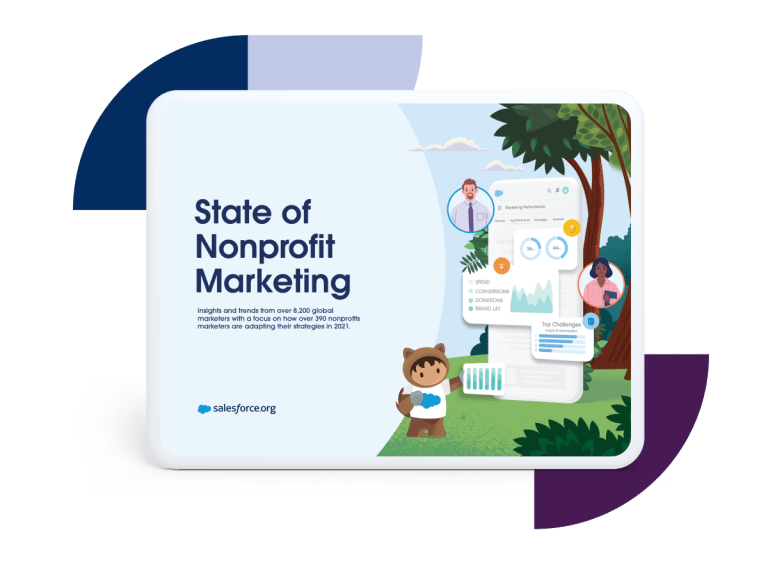The benefits of email marketing for nonprofits
Email marketing for nonprofits is an effective way to engage with supporters, increase donations, and share the impact your organization has on your mission. In this article, we’ll talk about why email marketing is important, key strategies to consider, a few types of emails to get you started, and some KPIs to begin measuring your success.
Many conversations about email marketing begin with the idea that emails are a digital form of direct mail (a tried and true nonprofit marketing strategy). Particularly when compared to direct mail, email marketing is an efficient and cost-effective way to connect with supporters. It’s an opportunity to connect with new and existing supporters in ways that are most impactful for them. While there are similarities, email marketing is its own unique channel of communication with a wide range of benefits.
One of the main benefits of nonprofit email marketing is data and the speed you have access to it! There’s a vast amount and diversity of types of data available to use from email marketing, and you can use it to make decisions quickly and optimize a live campaign. That data is also the information you need to help you make content that’s relevant and engaging to your supporters. This creates a personalized experience that strengthens their bond to your organization.

“If we see a spike in engagement, we’re going to dig into that, look at the data, and begin to prioritize what led to the increase to keep our story relevant to our constituents. We know lifetime engagement goes up if a constituent is engaged in multiple ways.”
– Bonnie Beauchamp, Lead Systems Analyst, Atlanta Mission
Strategies for nonprofit email marketing
Now that you’re excited about what nonprofit email marketing can do for your organization, let’s go over a few key strategies.
1. Campaign planning
Think about the major moments in your calendar year and how you want to communicate these to your supporters. You’ll develop a full plan later on, but start to align your desired campaigns to your calendar.
2. Preparing for measurement
Defining and tracking your campaigns will help you to measure the success of your email marketing efforts. For each campaign, be sure to track any associated assets such as emails and donation forms. This will help you identify what is most effective and begin to invest more in what’s working. For example, if you send three emails as a part of a new fundraising campaign, track each separately so that you’ll know which is most effective.
3. Deliverability
A seemingly invisible but often overlooked element of a good email marketing strategy is deliverability. Deliverability indicates whether or not your email is actually making it into your supporters’ inboxes. Make sure email service providers (ESPs) and supporters are not flagging your content as spam. One way to mitigate this is to make sure your content is thoughtful, personalized, and simple to understand. The recipient should invite messages, meaning they’ve signed up to receive your emails. Avoid overusing trigger words like “urgent” in your email subject lines, too. The Anti-Defamation League (ADL) was able to get their deliverability rate to over 95%.
4. Data integrity
Making sure your email addresses are accurate and deduplicated not only simplifies a marketer’s efforts; it also helps to create a great experience for your supporters. Have you ever received two copies of the exact same email at the same time? It’s likely the result of duplicates in the sender’s data. For example, the sender has two records for you — one under Sam and one under Samantha. Because the sender doesn’t deduplicate the data, you receive two emails. These kinds of errors erode trust with your supporters. A strong commitment to data integrity also ensures that your message is reaching the right person.
5. Email content
This is the time for your organization to shine! Brainstorm what you know about your organization that might interest a supporter. Begin to weave this into an overarching narrative for your organization. Your email content is where your storytelling comes to life! But, make sure to keep your emails brief. A great rule of thumb is to limit each email to one topic. Here are a few more quick tips:
- Keep text to a minimum
- Use imagery (photos or videos) as much as you can
- Have a very clear call to action
- Test your emails before sending
6. Personalization
Making content feel personalized is critical to the success of any marketing campaign, and email is no exception. The State of Marketing Report found that 60% of surveyed supporters say nonprofit communications are not personalized to them! This means we’re making appeals for time and donations without taking into account what’s meaningful to our supporters. Yikes! Use the data you have about your supporters to make sure the content you send them is tailored to their preferences where possible. Learn more about segmenting and personalization in the Marketing Trailguide for More Personalized Communications.
-
60%of surveyed supporters say nonprofit communications are not personalized to them.
Types of emails nonprofits can send
Remember the list of meaningful moments you created earlier? Reference this list while you think about your different audiences and what types of communications they should receive. Start compiling a list of all the possibilities. This could include welcome emails for new supporters, thank you messages for donors, newsletters for program participants, event confirmations for volunteers, donation appeals for board members, and many others.
Now that you have a strong foundation of strategy, here are a few types of emails or journeys you can send. There are so many opportunities to be creative here, so consider these inspiration:
1. Onboarding
When a new supporter indicates interest in your organization, you want to make sure they get a proper welcome. Use this opportunity to introduce your new supporters to:
- Your mission
- Your programs
- Your impact
- How they can get involved
2. Engagement
Engagement helps your supporters stay connected to your mission and is a great way to share what’s happening in your organization. Here are some ways to engage supporters through email:
- Communicate recent successes
- Be open about your needs
- Explain the impact of donations
- Ask supporters what’s top of mind for them
- Send event details
- Share social moments related to your mission
3. Appeals
An appeal is a direct request to your supporters, often for donations. You’ve connected with your supporters, you know what’s meaningful to them, you’ve communicated your needs, and now you’re asking them to participate with you. This could mean donating, volunteering, or advocating. Remember, all of the standard best practices for email still apply: keep it direct, easy to read, and simple. Make the call-to-action button easy to find, ensure all of your links are working, and align the content on your landing pages to the messaging in your email.
4. Thank you/follow-ups
Thanking your supporters is so important and often overlooked. Sending thank you emails may seem like an obligation, but it goes a long way to make your donors feel seen and appreciated. Many donors will make a second donation upon receipt of the thank you email. This is a great opportunity to remind donors of their impact and invite them further into your mission.
5. Mission moments
Depending on your mission, you may find that there are times during the year when it seems like the whole world is talking about what’s important to your organization. For example, back to school may be a critical time for nonprofits focused on education. These moments are a great time to keep supporters informed on your ongoing efforts toward a goal that may be more top of mind for them. These opportunities rise above typical engagement activity and help to elevate your mission to the next level.

Report
State of Nonprofit Marketing Report
Insights and trends on how nonprofit marketers have adapted their strategies in 2021.
Measuring the success of email marketing
The importance of measuring the impact of your email marketing can’t be overstated. This data is the key to understanding what is working and what isn’t so you can adjust your strategy accordingly. As we move into a “cookieless future,” determining whether or not your supporters are engaging with your content (and how) will be critical to your success. Ultimately, what you want to know is “Are my supporters inspired to action by the content I’m sending?” The metrics listed below offer a few ways to answer this question. Want to learn more? Check out our complete guide to nonprofit KPIs.
1. Email delivery rate
This number will tell you whether or not your emails are even making it to your supporters’ inboxes. It doesn’t matter how good your content is if it’s not being delivered. This will impact your deliverability and your ability to improve it.
2. Open rate
Open rate is the percentage of people who opened your email out of the total number of emails you sent. This will give you insights into deliverability and general supporter sentiment. When analyzing your open rate, you should always consider your subject line. The email subject line is the first thing your supporters will see and the reason for opening. If your open rates are low or trending down, consider doing a test on your subject lines and see if you can come up with something interesting and personalized enough to inspire an open.
3. Click-through rate
A click through rate is the percentage of people who clicked through for more information after they’ve opened the email. This will tell you if your content has inspired action. You’ve got your subject lines working well and folks have opened the email, but are they now clicking through to learn more? When you’re setting up landing pages, connect it to the email to understand where your supporters are clicking from.
4. Conversion
This is the most important KPI in terms of impact. Did people take the action you hoped for? Did you get volunteer sign-ups? Did donors give according to the need you identified? You’ll be able to identify the impact of each email and campaign. This is helpful information for building effective strategies moving forward. But remember, the success of your email marketing is also built on all of your prior engagement. So make sure to have a robust nonprofit marketing strategy that includes many channels in addition to email. It all works together!
Salesforce for Nonprofits provides Marketing & Engagement tools that help build relationships between organizations and supporters to effect change. Knowing your community means you can implement personalization at every touch point through a supporter’s experience and grow your impact towards your mission.
